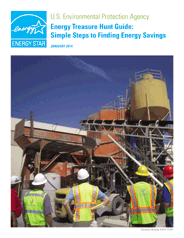E3 Sustainability Tools


E3 has assembled more than 60 tools and resources to help participants, stakeholders, and assessment teams address various area of improvement.
On this page:
- Sustainable Manufacturing Tools
- Life Cycle Assessment Tools
- Energy Efficiency Tools
- Carbon Footprint Tools
- Materials Management: Toxic Chemicals and Pollution Prevention Tools
- Community Development Tools
- Worker Safety Tools
- Workforce Development Tools
- Funding and Other Resources
- Manufacturing Industry Resources
Sustainable Manufacturing Tools
- Sustainable Manufacturing Curriculum: Greening the Future by Educating Tomorrow's Workforce—As sustainable manufacturing takes hold across the country, the demand for employees who are trained to identify opportunities for improving process efficiencies and preventing environmental wastes will explode.
- International Trade Administration Sustainable Manufacturing 101 Module—This module is designed to familiarize companies, particularly small to medium-sized manufacturers, with key concepts, approaches, strategies, terminology, and regulations related to sustainable manufacturing. The module guides users through sustainable manufacturing's various aspects to help companies identify opportunities for savings and value enhancements throughout the production cycle and supply chain.
- The OECD Sustainable Manufacturing Toolkit—This toolkit provides a practical starting point for businesses around the world to improve the efficiency of their production processes and products in a way that contributes to sustainable development and green growth.
- Lean Manufacturing and the Environment—These tools show how manufacturers can use lean and green methods to reduce environmental wastes while meeting other goals such as improving product quality, reducing costs, and enhancing customer responsiveness.
- The Global Social Compliance Programme (GSCP): The Equivalence Process (EP)—This tool is designed to help businesses benchmark their efforts to improve working and environmental conditions in global supply chains.
- Global Environmental Management Initiative (GEMI) Water Sustainability Tool—This tool helps individual companies build a business water strategy that tracks water use, identifies water supply risks and savings opportunities, and builds a business case for implementing improvements.
- GEMI Solutions—This collection of tools and resources is for business professionals seeking information on environmental and sustainability management issues and can serve as a guide to assist companies in achieving sustainability goals.
Life Cycle Assessment Tools
- Life Cycle Assessment (LCA): Principles and Practice—This tool provides an introductory overview of LCA along with a description of general uses and major components of the technique. It is designed for use by companies, federal facilities, industry organizations, and academia and describes how to incorporate life-cycle-based environmental performance considerations into decision-making processes.
- U.S. Life Cycle Inventory Database—This tool from the National Renewable Energy Laboratory (NERL) provides individual gate-to-gate, cradle-to-gate, and cradle-to-grave accounting of the energy and material flows into and out of the environment that are associated with producing a material, component, or assembly in the U.S.
- Eco-LCA™—Life Cycle Assessment with Full Ecological Accounting—This framework accounts for the role of ecosystem goods and services in the life cycle of economic activities.
- The Economic Input-Output Life Cycle Assessment (EIO-LCA)—This tool estimates the materials and energy resources required for, and the environmental emissions resulting from, activities in our economy.
Energy Efficiency Tools
- ENERGY STAR Treasure Hunt Guide: Simple Steps to Finding Energy Savings—An Energy Treasure Hunt is a two- to three-day event that engages employees in identifying low-cost energy savings opportunities from behavioral, operational, and maintenance actions. This 31-page guidebook provides step-by-step guidance on how to organize and execute an Energy Treasure Hunt.
- U.S. Department of Energy's Industrial Advanced Manufacturing Office (AMO) Tools Suite—These tools cover a wide range of advanced manufacturing applications from steam, compressed air, and fans to combined heat and power(CHP), motors/pumps, and more.
- ENERGY STAR Guidelines for Energy Management—This tool, based on the successful practices of ENERGY STAR partners, is designed to assist organizations in improving energy and financial performance.
- ENERGY STAR Industrial Energy Guides—This tool serves as a resource on trends in energy use and energy intensity in the industrial sector and can be used to identify areas for improvement, evaluate potential energy improvement options, develop action plans and checklists for an energy program, and educate company employees.
- ENERGY STAR Industrial Benchmarking Tools—These tools provide manufacturers with a simple means to track energy use, set baselines, establish energy and emissions reduction goals, and evaluate progress toward goals.
- I2SL Laboratory Energy Benchmarking Initiative—This Web-based database tool contains energy use information from more than 200 laboratory facilities and allows users to benchmark energy performance in terms of whole-building metrics (e.g., BTU/sf-yr) as well as system-level metrics (e.g., ventilation W/cfm).
- Back of the Envelope Calculator—This calculator is a learning tool that allows anyone to interact with a building as an energy system. You can see real-time energy connections between building components, isolate the effects of changing a single energy parameter, or produce concept-level energy and CO2 emissions estimates.
- ACEEE Energy Efficiency and Pollution Control Calculator—This calculator assists users in determining the costs and air quality benefits of some basic energy efficiency policies and allows them to compare those options with more piecemeal approaches to reducing air pollution.
Carbon Footprint Tools
- Waste Reduction Model (WARM)—This model helps solid waste planners and organizations track and voluntarily report greenhouse gas (GHG) emissions reductions from several different waste management practices. WARM is available both as a Web-based calculator and as a Microsoft Excel spreadsheet.
- P2 Cost and GHG Calculators—These two calculators are designed to help measure the environmental and economic performance results of P2 activities and can demonstrate the unique multimedia perspective that P2 brings to GHG reductions and cost savings.
- Simplified Greenhouse Gas (GHG) Emissions Calculator—These three tools are designed to help small businesses develop a corporate wide inventory and establish a plan to ensure GHG data consistency as they track progress towards reaching an emissions reduction goal.
- Small Business Carbon Footprint Calculator—This tool enables small business owners or managers in the U.S. to calculate the carbon footprint of their business and make customized pledges to reduce carbon footprints and save money. Smart defaults based on industry, size, and city pre-populate all fields but can be adjusted to quickly assess the footprint from all business expenditures. The calculator also shows comparisons to similar businesses as well as state and national benchmarks.
Materials Management: Toxic Chemicals and Pollution Prevention Tools
- Chemical Screening Tool for Exposures & Environmental Releases (ChemSTEER)—This tool estimates occupational inhalation and dermal exposure to a chemical during industrial and commercial manufacturing, processing, and use operations involving the chemical. It also estimates releases of a chemical to air, water, and land that are associated with industrial and commercial manufacturing and processing.
- Tool for the Reduction and Assessment of Chemical and Other Environmental Impacts (TRACI)—This tool examines the potential impacts associated with the raw material usage and chemical releases resulting from production processes.
- ChemView—Use this database to get information on chemical health and safety data received by EPA and EPA's assessments and regulatory actions for specific chemicals under the Toxic Substances Control Act (TSCA).
- Electronics Product Environmental Assessment Tool (EPEAT)—This searchable global registry for green electronics helps purchasers, manufacturers, resellers, and others find and promote environmentally preferable products.
Community Development Tools
- The Investing in Manufacturing Communities Partnership (IMCP)—This resource pulls together existing federal planning grant and technical assistance resources and best practices in economic development.
- Zoom Prospector—This tool provides a way for new and expanding businesses to find, compare, and deeply analyze communities and available properties nationwide. The map-based search can greatly simplify and speed up the site selection process, freeing companies to be able to quickly and accurately make informed decisions based on numerous data sets including demographic, business, transportation, and property information.
- U.S. Cluster Mapping—This tool, developed by a consortium of institutions and U.S. regions and supported by the U.S. Department of Commerce's Economic Development Administration, helps businesses, organizations, policymakers, and researchers uncover and understand clusters in order to strengthen regional economies, stimulate innovation, and grow business.
- General Services Administration (GSA): Sustainable Facilities Tool—This tool is designed to simplify, for both government and private-sector property managers, sustainable building practices and compare options for renovation projects. It offers useful sustainable guidance for facility managers, procurement professionals, leasing specialists, and project managers.
Worker Safety Tools
- Worker Education and Training Program (WETP) Clearinghouse—This clearinghouse tool catalogues studies, white papers, and reports on occupational health and workplace safety.
- Occupational Safety and Health Administration (OSHA)'s Establishment Search—This database allows users to search for OSHA enforcement inspections by the name of the establishment. Information can also be obtained for a specified inspection or inspections within a specified Standard Industrial Classification (SIC).
- OSHA eTools, eMatrix, Expert Advisors and v-Tools—These stand-alone, interactive, Web-based training tools offer guidance on occupational safety and health topics. They are highly illustrated and use graphical menus. Some also use expert system modules, which enable the user to answer questions and receive reliable advice on how OSHA regulations apply to their work site
- OSHA's Transitioning to Safer Chemicals: A Toolkit for Employers and Workers—By using this toolkit, businesses can improve worker well-being through eliminating or reducing hazardous chemicals, while creating other benefits.
- Workplace Safety Tool Kit—This toolkit is a compilation of information, data sheets, tools, and other useful information on worker safety and protection.
Workforce Development Tools
- WorkforceGPS: Workforce Solutions—This tool is an e-learning, knowledge-sharing Web space that offers workforce professionals, employers, economic development, and education professionals a dynamic network featuring innovative workforce solutions.
- 21st Century Registered Apprenticeship—The tool is a strong model for all industries needing skilled workers and for all workers and job seekers needing a leg up to a better life and long-term career.
- Sustainability Education and Economic Development Center—This resource aims to advance sustainability and green workforce development practices at community colleges by sharing innovative models and resources and building the capacity of college administrators, faculty, and staff to contribute as leaders.
Funding and Other Resources
- Database of State Incentives for Renewables & Efficiency (DSIRE)—This database offers a comprehensive source of information on state, federal, local, and utility incentives and policies that support renewable energy and energy efficiency. Established in 1995 and funded by the U.S. Department of Energy, DSIRE is an ongoing project of the North Carolina Solar Center and the Interstate Renewable Energy Council, Inc.
- Business USA—These resources help small businesses and exporters quickly connect to the services and information needed to efficiently and effectively navigate the federal bureaucracy.
- U.S. Department of Energy's Office of Science Grants and Contracts—This database of financial and technical incentives, tools, and resources helps commercial and industrial managers make energy efficiency upgrades in their facilities.
Manufacturing Industry Resources
- NIST MEP's Research and Reports—NIST compiled recent reports and studies about manufacturing policy and practice.
- Census Bureau Facts for Features—In observance of Manufacturing Day (in October), the Census Bureau highlighted statistics throughout the manufacturing industry.
